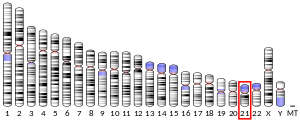MX1
Appearance
(Redirected from MX1 (gene))
Interferon-induced GTP-binding protein Mx1 is a protein that in humans is encoded by the MX1 gene.[5][6]
In mice, the interferon-inducible Mx protein is responsible for a specific antiviral state against influenza virus infection. Furthermore, the human orthologue MxA is a major determinant for influenza viruses of animal origin.[7] The protein encoded by this gene is similar to the mouse protein as determined by its antigenic relatedness, induction conditions, physicochemical properties, and amino acid analysis. This cytoplasmic protein is a member of both the dynamin superfamily and the family of large GTPases.[6]
References
[edit]- ^ a b c GRCh38: Ensembl release 89: ENSG00000157601 – Ensembl, May 2017
- ^ a b c GRCm38: Ensembl release 89: ENSMUSG00000023341 – Ensembl, May 2017
- ^ "Human PubMed Reference:". National Center for Biotechnology Information, U.S. National Library of Medicine.
- ^ "Mouse PubMed Reference:". National Center for Biotechnology Information, U.S. National Library of Medicine.
- ^ Haller O, Staeheli P, Kochs G (Jul 2007). "Interferon-induced Mx proteins in antiviral host defense". Biochimie. 89 (6–7): 812–8. doi:10.1016/j.biochi.2007.04.015. PMID 17570575.
- ^ a b "Entrez Gene: MX1 myxovirus (influenza virus) resistance 1, interferon-inducible protein p78 (mouse)".
- ^ Ciminski, Kevin; Chase, Geoffrey; Beer, Martin; Schwemmle, Martin (2021). "Influenza A Viruses: Understanding Human Host Determinants". Trends in Molecular Medicine. 27 (2): 104–112. doi:10.1016/j.molmed.2020.09.014. PMID 33097424. S2CID 225058479.
Further reading
[edit]- Pavlovic J, Haller O, Staeheli P (1992). "Human and mouse Mx proteins inhibit different steps of the influenza virus multiplication cycle". J. Virol. 66 (4): 2564–9. doi:10.1128/JVI.66.4.2564-2569.1992. PMC 289059. PMID 1548781.
- Horisberger MA (1992). "Interferon-induced human protein MxA is a GTPase which binds transiently to cellular proteins". J. Virol. 66 (8): 4705–9. doi:10.1128/JVI.66.8.4705-4709.1992. PMC 241296. PMID 1629950.
- Petersen MB, Slaugenhaupt SA, Lewis JG, et al. (1991). "A genetic linkage map of 27 markers on human chromosome 21". Genomics. 9 (3): 407–19. doi:10.1016/0888-7543(91)90406-5. PMID 1674496.
- Horisberger MA, McMaster GK, Zeller H, et al. (1990). "Cloning and sequence analyses of cDNAs for interferon- and virus-induced human Mx proteins reveal that they contain putative guanine nucleotide-binding sites: functional study of the corresponding gene promoter". J. Virol. 64 (3): 1171–81. doi:10.1128/JVI.64.3.1171-1181.1990. PMC 249231. PMID 2154602.
- Pavlovic J, Zürcher T, Haller O, Staeheli P (1990). "Resistance to influenza virus and vesicular stomatitis virus conferred by expression of human MxA protein". J. Virol. 64 (7): 3370–5. doi:10.1128/JVI.64.7.3370-3375.1990. PMC 249583. PMID 2161946.
- Aebi M, Fäh J, Hurt N, et al. (1990). "cDNA structures and regulation of two interferon-induced human Mx proteins". Mol. Cell. Biol. 9 (11): 5062–72. doi:10.1128/mcb.9.11.5062. PMC 363658. PMID 2481229.
- Weitz G, Bekisz J, Zoon K, Arnheiter H (1990). "Purification and characterization of a human Mx protein". J. Interferon Res. 9 (6): 679–89. doi:10.1089/jir.1989.9.679. PMID 2607176.
- Maruyama K, Sugano S (1994). "Oligo-capping: a simple method to replace the cap structure of eukaryotic mRNAs with oligoribonucleotides". Gene. 138 (1–2): 171–4. doi:10.1016/0378-1119(94)90802-8. PMID 8125298.
- Melén K, Keskinen P, Ronni T, et al. (1996). "Human MxB protein, an interferon-alpha-inducible GTPase, contains a nuclear targeting signal and is localized in the heterochromatin region beneath the nuclear envelope". J. Biol. Chem. 271 (38): 23478–86. doi:10.1074/jbc.271.38.23478. PMID 8798556.
- Ponten A, Sick C, Weeber M, et al. (1997). "Dominant-negative mutants of human MxA protein: domains in the carboxy-terminal moiety are important for oligomerization and antiviral activity". J. Virol. 71 (4): 2591–9. doi:10.1128/JVI.71.4.2591-2599.1997. PMC 191379. PMID 9060610.
- Fernández M, Quiroga JA, Martín J, et al. (1997). "Impaired interferon induction of human MxA protein in chronic hepatitis B virus infection". J. Med. Virol. 51 (4): 332–7. doi:10.1002/(SICI)1096-9071(199704)51:4<332::AID-JMV12>3.0.CO;2-K. PMID 9093949. S2CID 12578068.
- Suzuki Y, Yoshitomo-Nakagawa K, Maruyama K, et al. (1997). "Construction and characterization of a full length-enriched and a 5'-end-enriched cDNA library". Gene. 200 (1–2): 149–56. doi:10.1016/S0378-1119(97)00411-3. PMID 9373149.
- Li Y, Youssoufian H (1998). "MxA overexpression reveals a common genetic link in four Fanconi anemia complementation groups". J. Clin. Invest. 100 (11): 2873–80. doi:10.1172/JCI119836. PMC 508494. PMID 9389754.
- Kochs G, Trost M, Janzen C, Haller O (1998). "MxA GTPase: oligomerization and GTP-dependent interaction with viral RNP target structures". Methods. 15 (3): 255–63. doi:10.1006/meth.1998.0629. PMID 9735310.
- Weber F, Haller O, Kochs G (2000). "MxA GTPase blocks reporter gene expression of reconstituted Thogoto virus ribonucleoprotein complexes". J. Virol. 74 (1): 560–3. doi:10.1128/JVI.74.1.560-563.2000. PMC 111572. PMID 10590150.
- Hattori M, Fujiyama A, Taylor TD, et al. (2000). "The DNA sequence of human chromosome 21". Nature. 405 (6784): 311–9. Bibcode:2000Natur.405..311H. doi:10.1038/35012518. PMID 10830953.
- Hijikata M, Ohta Y, Mishiro S (2000). "Identification of a single nucleotide polymorphism in the MxA gene promoter (G/T at nt -88) correlated with the response of hepatitis C patients to interferon". Intervirology. 43 (2): 124–7. doi:10.1159/000025035. PMID 10971132. S2CID 19445539.
- Engelhardt OG, Ullrich E, Kochs G, Haller O (2002). "Interferon-induced antiviral Mx1 GTPase is associated with components of the SUMO-1 system and promyelocytic leukemia protein nuclear bodies". Exp. Cell Res. 271 (2): 286–95. doi:10.1006/excr.2001.5380. PMID 11716541.
- Hijikata M, Mishiro S, Miyamoto C, et al. (2002). "Genetic polymorphism of the MxA gene promoter and interferon responsiveness of hepatitis C patients: revisited by analyzing two SNP sites (-123 and -88) in vivo and in vitro". Intervirology. 44 (6): 379–82. doi:10.1159/000050075. PMID 11805446. S2CID 46752867.
- Kochs G, Haener M, Aebi U, Haller O (2002). "Self-assembly of human MxA GTPase into highly ordered dynamin-like oligomers". J. Biol. Chem. 277 (16): 14172–6. doi:10.1074/jbc.M200244200. PMID 11847228.





